All About Art Deco pt 1: European Art Deco
Hello there!
My name is Kate and I’m one of the Intake Specialists at Mimi’s Attic. A big part of my job is being able to identify different styles of furniture. When I started in this position, I began researching different styles and periods and was given the opportunity to really explore a particular style that interested me. I chose Art Deco as it has been a style that I’ve always loved but didn’t know that much about. Unknowingly my coworker Eric also chose Art Deco! We decided to team up and break it down into two parts. Here’s a little bit of what I’ve learned. I hope you enjoy!
The Art Deco movement, which was a style of visual arts, architecture and design, originated in Paris just before WWI and lasted till about 1940. The style takes its name from the Exposition Internationale des Arts Decoratifs held in Paris in 1925 as a showcase for new inspiration. Widely speaking, Art Deco covers all styles during the interwar period, but there are
many variations within this from the sleeker curves that you see in American styles to the geometric lines of the more European influence. Art Deco had a very wide array of influences- Cubism, the Ballet Russes, Fauvism, Italian Futurism, Russian Constructivism, Egyptology, and African Tribal Art among many others. The previous artistic movement had been 'Art Nouveau' which was heavily influenced by floral motifs and intricate design.

The swirls and floral motifs of Art Nouveau were smoothed out into sleeker, bolder, curved or geometric lines. The new Art Deco style was also influenced by the technological advances of the time and therefore had more geometric lines, and influences of aviation, like streamlined curves.

and Wood Rolling Liquor Cabinet (right)
As well as being influenced by technological advances and affordable travel (meaning aviation was totally 'in' during this time), there were discoveries being made around the world which heavily influenced the style. The pyramids of Egypt, The tomb of Tutankhamun and various archeological digs influenced in the way of colour, shape and form. The silver-screen was also becoming a big influence, with the glamour of a new, exciting Hollywood and what was being seen on cinema screens starting to make its way across the globe and into homes. These motifs combined with machine age elements create the basics of the Art Deco look.

In France the early art deco style featured luxurious and exotic materials such as ebony, and ivory and silk, very bright colors and stylized motifs, particularly baskets and bouquets of flowers of all colors, giving a modernist look. Metals such as chrome and brass were very popular at the
time, other finishes also include opal, glass, leather, tortoiseshell, mirror, mother of pearl, exotic animal skins, velvet and walnut wood in high shine light and dark finishes.

Club chairs with sloped, curved arms were popular, as were light burr walnut pieces.

Everything was high end, polished, glamorous and luxurious! Art Deco is one of the most lasting styles to come out of the past 100 years; it has become so ingrained in our day-to-day lives that we often don’t notice it at all. Everyday things—from fonts to salt and pepper shakers to movie
theaters—are often shaped by this modern styles high hopes for the future. I hope you enjoyed this post and stay tuned for Part 2!
- Kate
